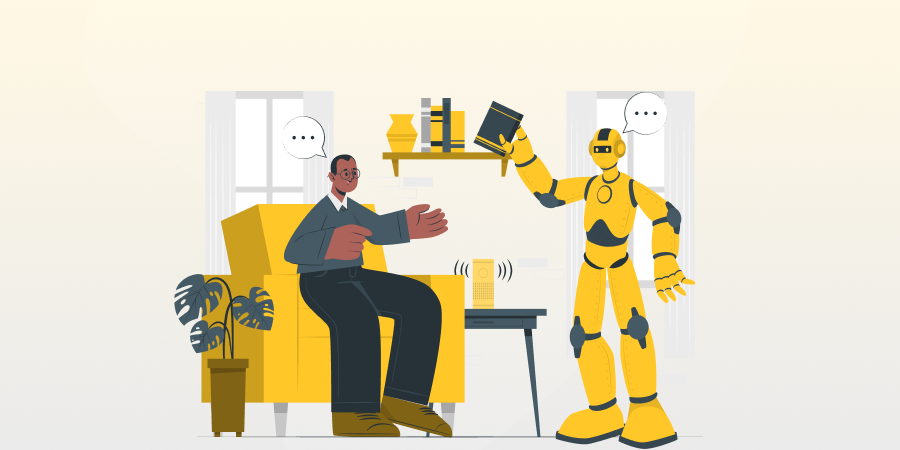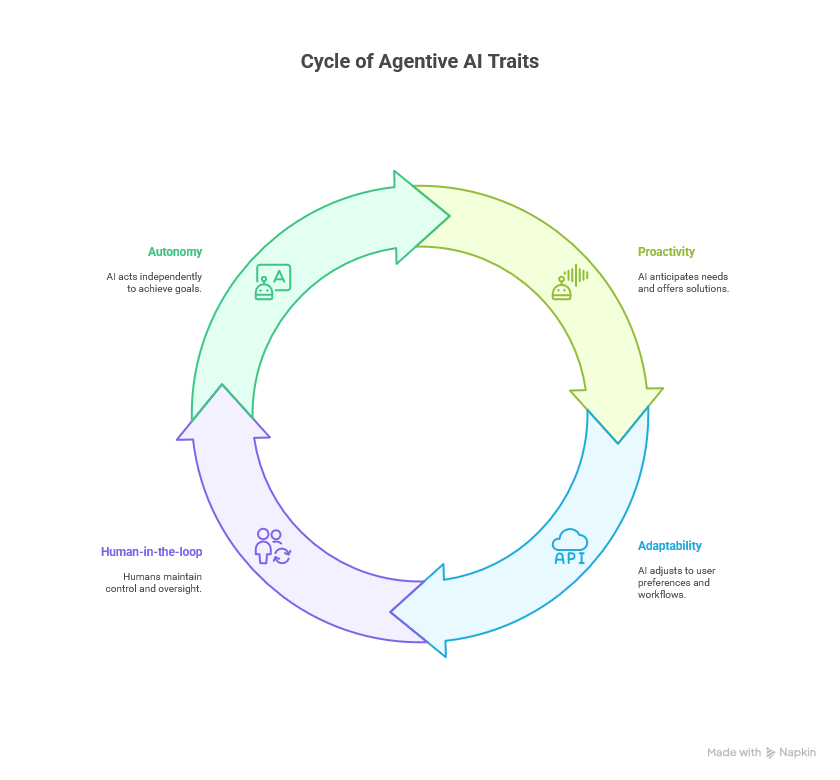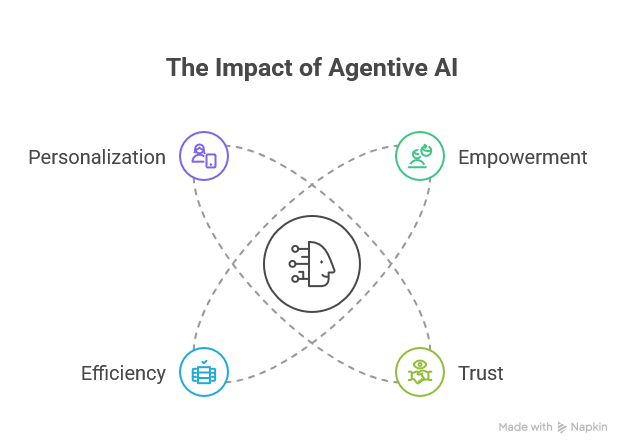
Agentive AI: The Ultimate Guide to Human-Centered Ar...
Artificial Intelligence has changed the way we interact with technolog...

Artificial Intelligence has changed the way we interact with technology. From automating workflows to generating text, images, and other content, AI has become an integral part of everyday tools. But as it continues to grow more advanced, one important question remains: how do we design systems that work with us, not just for us?
This is where agentive AI comes in.
Unlike traditional automation, agentive AI doesn’t just follow set rules. And unlike generative AI, it doesn’t simply create content. Instead, it acts on behalf of users while keeping them in control. It learns from behavior, adapts to needs, and offers smart, proactive support. The goal isn’t to replace human effort, it’s to strengthen it.
This change in AI design shifts us from merely automating tasks to collaborating with AI. Agentive AI bridges the gap between how people think and how machines operate. It lets you stay focused on important things while the system takes care of the small stuff. In this blog, we’ll explore what agentive AI is, how it works, where it’s being used, and why it’s key to building human-centered technology.
Agentive AI is a type of artificial intelligence that works with people instead of working for them. It helps you get things done by taking action on your behalf, but you’re always the one in control.
Unlike regular automation, which only follows fixed rules, or generative AI, which creates things like text or images, agentive AI goes a bit further. It watches how you work, learns your preferences, and offers helpful suggestions. It can even take care of small tasks on its own, so you can focus on what’s more important.
Think of it like a smart assistant that’s always ready to help. It doesn’t try to replace you. It simply supports you, making your work easier and faster.
The idea behind agentive AI is to create a better balance between people and machines where AI does the background work, and you stay in charge of the big picture.
Agentive AI stands out by blending smart automation with human guidance. It can act on its own, offer helpful suggestions, and adapt to your way of working while keeping you in control. Here are four key traits that make this type of AI truly people-focused:

Agentive AI can make decisions and take action without waiting for constant input. It’s capable of operating on its own, handling small but meaningful tasks like updating schedules, organizing files, or flagging issues. This helps reduce your mental load and allows you to stay focused on bigger priorities.
But autonomy doesn’t mean giving up control; the system still follows your direction and works within the limits you’ve set. It’s like having a reliable assistant who knows when to help and when to step back.
Instead of waiting for instructions, agentive AI takes initiative. It looks ahead, identifies what might be useful, and steps in with timely suggestions or actions. Whether it’s reminding you to follow up with a client or recommending a better time for a meeting, it works in the background to make your day smoother.
This proactive support means you don’t always have to think two steps ahead the system does it for you. And because it learns over time, those suggestions become more relevant and helpful the more you use it.
One of the most powerful aspects of agentive AI is its ability to adapt. It learns from how you work your habits, your preferences, and your pace. Over time, it personalizes its behavior to better match your workflow.
For example, if you consistently decline certain types of suggestions, it will offer fewer of them. If you always prefer tasks arranged in a certain way, you will remember that. This makes the experience feel less robotic and more natural, almost like working with someone who truly understands your style.
While agentive AI can act independently, it’s always designed to keep you involved. You’re the one guiding the system, approving key actions, and making the final call. This human-in-the-loop approach ensures that AI remains a helpful partner, not a decision-maker.
It also builds trust, because you’re never left wondering why something happened; you’re part of the process. Whether it’s accepting a suggestion, tweaking a response, or stopping an action altogether, you always have the last word.
| Feature | Automation | Generative AI | Agentive AI |
| User Control | Minimal | Medium | High |
| Output Ownership | Fixed Rules | AI-Generated Content | Human-guided actions |
| Adaptiveness | Low | Medium | High |
| Collaboration Style | Replace Human Effort | Co-create | Augment Human Decisions |
Agentive AI is reshaping work across industries by combining automation with human judgment. Instead of replacing people, it supports them in anticipating needs, offering guidance, and adapting over time. Here are some key areas where it’s already making an impact.
In a fast-moving, high-stakes environment like healthcare, timing and accuracy matter. Agentive AI supports medical professionals by handling routine monitoring and surfacing important data. It can track patient vitals, alert staff to early warning signs, or recommend care pathways, all while keeping doctors and nurses fully in charge.
By acting as a second set of eyes, it helps reduce errors, speeds up decision-making, and gives medical teams more time to focus on patients instead of paperwork.
When it comes to everyday work, agentive AI is like a personal assistant that understands how you operate. It learns from your patterns when you focus best, how you handle meetings, or what tasks tend to get delayed, and steps in with suggestions to keep you organized and on track.
Whether it’s re-prioritizing your to-do list, drafting a quick email, or flagging a meeting conflict, the system gives you the help you need without taking control of your schedule. The result is less mental clutter and more time to focus on what matters.
At home, agentive AI brings intelligence into the background. It doesn’t just follow commands, it learns how your household runs and makes thoughtful adjustments. For instance, it might dim the lights when you typically unwind in the evening or suggest adjusting the thermostat to save energy.
These small interactions add up, creating a home that feels more comfortable, efficient, and personalized without needing constant input. And if your needs change, it adapts.
In customer support, speed and context are key, and agentive AI helps agents deliver both. These systems work behind the scenes, pulling up past interactions, suggesting replies, or highlighting customer concerns before an agent even replies.
This kind of support helps agents respond faster and with more accuracy, all while maintaining a human tone. Unlike traditional bots, agentive AI isn’t there to replace people it’s there to make their work easier, especially in high-volume or complex service environments.
Agentive AI plays a key role in making artificial intelligence more human-focused. Instead of pushing people out of the loop, it brings them closer, giving them more control, better support, and a more personalized experience. Here’s why that matters:

Agentive AI is built to assist, not replace. It gives users the tools and insights they need to make confident decisions without handing over control. Instead of completing tasks for the user, it works alongside them, suggesting, nudging, and supporting in the background.
This kind of intelligent assistance helps people stay focused and in control while reducing the effort behind routine or complex tasks. When technology is designed this way, it doesn’t take away the power it gives it back.
With empowerment comes the need for trust. People need to feel confident that the system is acting in their best interest and understand how it works. Agentive AI supports this by being transparent.
It explains its suggestions, stays consistent, and gives users the ability to accept, decline, or adjust actions at any time. This openness builds a sense of reliability, making it easier for users to trust the AI without feeling like they’re handing over too much.
When users feel empowered and trust the system, they’re ready to move faster and agentive AI makes that possible. It reduces the time spent on repetitive tasks, helps prioritize what matters most, and brings just-in-time insights into the workflow.
Unlike traditional automation, it doesn’t remove the human it enhances their speed and focus by staying context-aware. The result is a smoother, more efficient experience that keeps users in control without slowing them down.
Every user works differently, and agentive AI respects that. It learns from individual behaviors, adapts to preferences, and adjusts its support accordingly. Whether it’s recognizing daily routines, suggesting content based on past choices, or adapting to changing priorities, the system becomes more in tune with each individual over time.
Eventually, it starts to feel less like a tool and more like a thoughtful assistant one that understands how each person likes to work and quietly shapes the experience around their needs.
Designing agentive AI is about making it work well for people. When it’s clear, flexible, and easy to control, it feels less like a machine and more like helpful support in everyday life.
Every good interaction starts with clarity. When people understand how a system works, they’re more likely to use it and trust it. That’s why thoughtfully designed agentive AI, often delivered through modern AI development services, should make its intentions visible by clearly explaining what it’s doing, why it’s suggesting something, and how the user can respond.
That might mean showing the data it used to make a decision or offering a short explanation with a suggestion. The goal is to remove uncertainty and build confidence. When the AI is open about its role, users don’t feel caught off guard; they feel informed and in control.
Clarity alone isn’t enough; users also need to feel like they’re in charge. Agentive AI should always offer suggestions and never impose actions. Whether it’s scheduling a meeting, prioritizing a task, or drafting a response, the final choice should belong to the user.
The system can guide and assist, but it should never force an outcome. This balance is what sets agentive AI apart from full automation. By leaving decisions in the user’s hands, the experience feels more respectful and more useful.
Once the user feels in control, the system can start to become more personal. Adaptability allows agentive AI to learn how each individual works and adjust its behavior accordingly. It can notice routines, pick up on changing needs, and tailor its support without needing to be reprogrammed.
Whether it’s adjusting the tone of suggestions, changing how often it prompts, or fine-tuning its priorities, adaptability helps the system grow alongside the user. Over time, the AI begins to feel less like software and more like a reliable assistant that understands how you work.
But to truly adapt, the system needs feedback. That feedback doesn’t always have to be explicit it can come from user actions, corrections, skipped steps, or even silence. The important part is that the AI pays attention and adjusts. Good feedback loops also give users a way to influence how the system evolves.
When people see that their behavior or input makes a difference, it creates a sense of collaboration. It feels less like using a tool and more like working with a partner who’s learning and improving every day.
Building agentive AI isn’t just about technology; it’s about people. These systems need to be helpful and smart, but also fair, respectful, and easy to trust. Getting that balance right takes thoughtful design and ongoing care. Here are some key challenges teams often face.
The first challenge is knowing how far the system should go. Agentive AI is designed to act on its own, but it needs clear limits. If it becomes too assertive, it risks feeling invasive or even controlling. If it holds back too much, it might not be useful at all.
Finding the right balance where the AI is helpful without overstepping is one of the most important parts of the design process. The goal is to give users the right kind of support, at the right time, without ever removing their ability to decide.
Once the system starts making decisions, another challenge comes into play: fairness. Agentive AI often learns from large sets of historical data, and that data can carry hidden biases. If left unchecked, those patterns can influence how the system treats different users, leading to uneven or unfair outcomes.
That’s why fairness can’t be treated as a final step it needs to be part of the design from the start. It requires diverse perspectives, careful testing, and a constant effort to make sure the system works well for everyone, not just some.
Even with fairness in place, users won’t feel safe unless their privacy is respected. Agentive AI systems often need access to personal data to offer meaningful support, things as habits, routines, or preferences. But collecting that kind of data comes with real responsibility.
Users should always know what’s being collected, why it’s needed, and how they can control it. Privacy isn’t just about checkboxes and settings; it’s about creating a system that feels trustworthy by design, not just by policy.
All of these pieces come together in the overall user experience. Even if the AI is ethical, fair, and respectful of privacy, it still has to feel helpful. If the experience is confusing, too technical, or constantly disruptive, people won’t engage with it, no matter how smart it is. Designing a smooth, intuitive experience is key to building trust.
That means knowing when to step in, when to stay out of the way, and how to offer guidance without overwhelming the user. A thoughtful UX turns intelligent features into everyday value.
Agentive AI is moving toward a future that’s less about controlling machines and more about working with them. It’s not just about doing tasks faster; it’s about giving support that feels natural, respectful, and genuinely helpful. Here are five key shifts shaping where things are headed.
The most noticeable shift will be in how people interact with AI. Instead of waiting for input, future agentive systems will take initiative, observing goals, understanding progress, and offering help without needing to be asked. This doesn’t mean acting on behalf of the user without consent; it means stepping in at the right time with the right kind of support.
Whether it’s streamlining repetitive work or nudging a task forward, collaboration like this turns AI into a quiet, capable partner that works with the user, not just for them.
As AI becomes more collaborative, it will also become more personal. It won’t just suggest articles or recommend products, it will shape its entire behavior based on how individuals think, work, and communicate. Some people might prefer fast, hands-off interactions.
Others may want more structure or detailed guidance. Future agentive systems will learn these preferences and adjust things like tone, timing, and frequency so the experience feels smooth, familiar, and genuinely helpful over time.
With that level of personalization and autonomy, ethical design becomes non-negotiable. As AI takes a more active role, users will expect clear boundaries, fairness, and full transparency. Future agentive systems will need to show how decisions are made, what data is being used, and why certain suggestions appear.
Giving people visibility and control over those things won’t just protect privacy, it will be central to building long-term trust and adoption. Ethical design won’t be a feature; it will be the foundation.
The future of agentive AI isn’t about building new systems, but it’s about making existing tools smarter. We’ll see AI integrated directly into the platforms people already use: workspaces, messaging apps, calendars, email, healthcare portals, and even home devices.
Instead of switching apps or learning new workflows, users will get small, helpful boosts exactly where they need them. This type of embedded support helps the AI fade into the background, showing up only when it adds real value.
As agentive systems become more present in our tools, they’ll also become more aware of context, recognizing when users are focused, in a rush, or just need space. Instead of interrupting with generic alerts or suggestions, AI will adapt its behavior based on the moment.
That might mean offering a gentle reminder during downtime, staying quiet during deep work, or shifting priorities based on user mood or schedule. This kind of sensitivity turns AI from a helpful system into something that actually feels supportive, aware, responsive, and respectful of how people work best.
Agentive AI isn’t just about making systems smarter; it’s about making them more helpful in ways that feel natural. Instead of replacing people, it works alongside them, offering support when it’s needed and staying out of the way when it’s not.
For agentive AI to truly work, it has to be designed with people in mind. That means being clear, fair, easy to trust, and flexible. The best systems won’t feel like machines; they’ll feel like something that quietly helps you do your job or manage your day.
As this technology grows, the goal isn’t to do more, it’s to do better. Agentive AI has the potential to make everyday tasks easier, decisions simpler, and experiences smoother all by understanding what people need and how they like to work.
Agentive AI is a type of artificial intelligence designed to assist people by performing tasks on their behalf. Unlike traditional AI, which often focuses on automating processes or analyzing data, agentive AI works alongside humans, giving them control while handling repetitive or time-consuming actions.
Agentive AI boosts productivity by handling routine tasks, offering smart suggestions, and acting when prompted. This allows people to focus on more important decisions and creative work, while the AI supports them in the background.
You can find agentive AI in tools like virtual assistants, smart home devices, healthcare apps, and customer service bots. These systems help users complete tasks more efficiently while keeping them in control of the outcomes.
Human-centered AI is built around user needs. It focuses on transparency, control, ethical behavior, and adaptability. These systems are designed to support users, not replace them, by working in partnership and learning from their actions.
Agentive AI helps businesses by improving customer interactions, speeding up workflows, and reducing manual effort. It supports employees by taking care of repetitive jobs, allowing them to focus on strategic tasks that require human insight.
Yes, when developed responsibly. Agentive AI is designed to follow ethical practices like ensuring user control, protecting data, and avoiding biased decisions. Proper guidelines and ongoing monitoring help keep these systems safe and trustworthy.